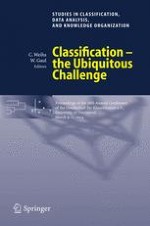2005 | Book
Classification — the Ubiquitous Challenge
Proceedings of the 28th Annual Conference of the Gesellschaft für Klassifikation e.V. University of Dortmund, March 9–11, 2004
Editors: Professor Dr. Claus Weihs, Professor Dr. Wolfgang Gaul
Publisher: Springer Berlin Heidelberg
Book Series : Studies in Classification, Data Analysis, and Knowledge Organization
